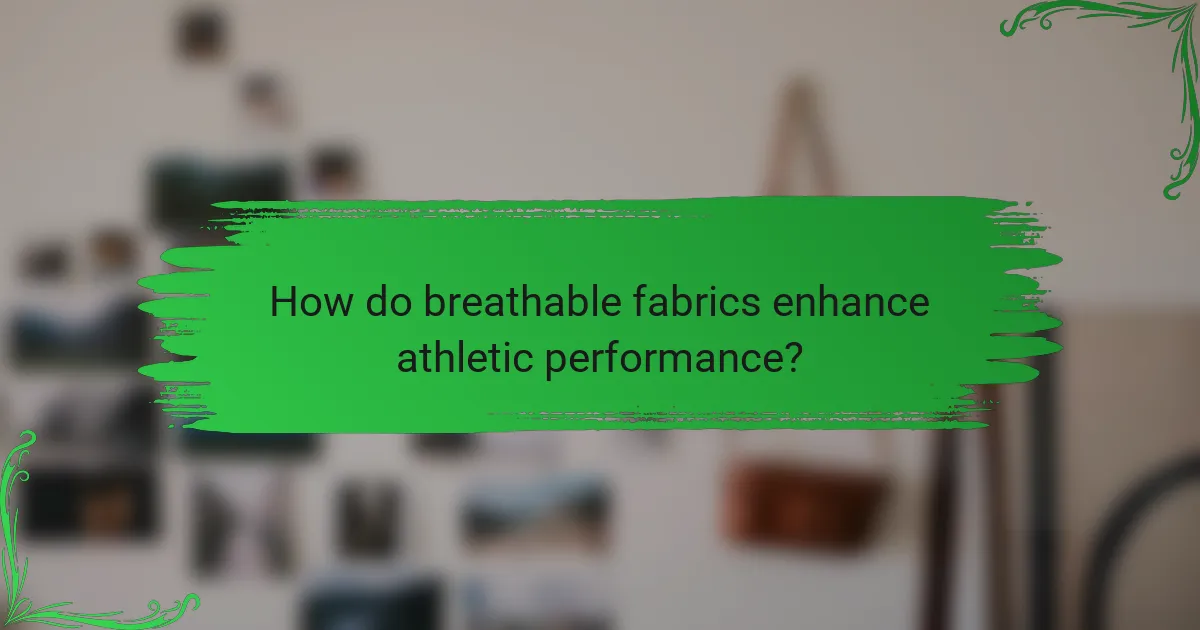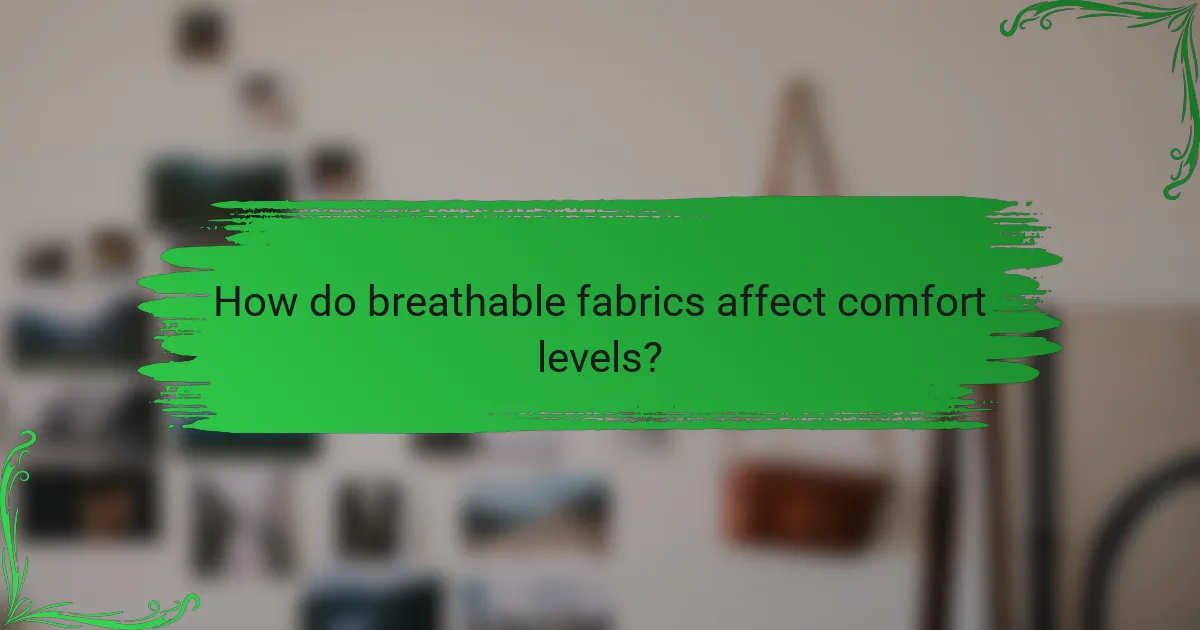Breathable fabrics play a crucial role in enhancing athletic performance by effectively managing moisture, increasing airflow, and regulating temperature. These materials, such as moisture-wicking polyester and merino wool, are particularly beneficial in humid climates, providing comfort and efficiency during physical activities. By promoting airflow and moisture management, breathable fabrics ensure a more enjoyable wearing experience, especially in warm conditions.

How do breathable fabrics enhance athletic performance?
Breathable fabrics significantly enhance athletic performance by improving moisture management, increasing airflow, and regulating temperature. These factors contribute to overall comfort and efficiency during physical activities, allowing athletes to perform at their best.
Improved moisture management
Breathable fabrics are designed to wick moisture away from the skin, keeping athletes dry and comfortable. This moisture management reduces the risk of chafing and skin irritation, which can hinder performance. Look for materials with moisture-wicking properties, such as polyester or nylon blends, which are effective in drawing sweat away from the body.
When selecting athletic wear, consider options with a hydrophilic finish that enhances moisture absorption. Fabrics that dry quickly can also help maintain comfort during intense workouts, allowing athletes to focus on their performance rather than discomfort.
Increased airflow and ventilation
Increased airflow is crucial for maintaining comfort during exercise, as it helps to dissipate heat and moisture. Breathable fabrics often feature mesh panels or open weaves that promote ventilation, allowing air to circulate freely around the body. This design helps athletes stay cool, especially in warm or humid conditions.
For optimal airflow, choose garments that incorporate strategic ventilation zones. These areas can significantly enhance breathability, making a noticeable difference in comfort levels during prolonged physical activity.
Enhanced temperature regulation
Breathable fabrics assist in temperature regulation by allowing heat to escape while keeping the body insulated during cooler conditions. This balance is essential for maintaining performance and preventing overheating. Fabrics that offer thermal regulation properties can adapt to changing temperatures, ensuring athletes remain comfortable in various environments.
When selecting athletic gear, consider layering breathable fabrics to enhance temperature control. For instance, a moisture-wicking base layer combined with a breathable outer layer can effectively manage body temperature, providing a competitive edge during workouts or competitions.

What are the best breathable fabrics for humid climates?
The best breathable fabrics for humid climates include moisture-wicking polyester, merino wool, and nylon blends. These materials effectively manage moisture and enhance comfort, making them ideal for hot and humid conditions.
Moisture-wicking polyester
Moisture-wicking polyester is designed to pull sweat away from the skin, allowing it to evaporate quickly. This fabric is lightweight and dries rapidly, making it a popular choice for active wear in humid environments.
When selecting moisture-wicking polyester, look for options with a tight weave for better breathability. Many athletic brands offer garments made from this material, often featuring mesh panels for enhanced airflow.
Merino wool
Merino wool is a natural fiber known for its excellent moisture management and temperature regulation. It can absorb moisture without feeling wet, making it suitable for humid climates where sweat is common.
This fabric is also odor-resistant and can be worn for extended periods without developing unpleasant smells. Choose lightweight merino wool garments for optimal comfort in warm, humid conditions.
Nylon blends
Nylon blends combine the durability of nylon with the moisture-wicking properties of other fibers, such as polyester. This combination results in fabrics that are both breathable and resistant to wear, ideal for outdoor activities in humid weather.
When selecting nylon blends, consider those with added spandex for stretch and comfort. Look for garments labeled as quick-drying to ensure they perform well in high humidity.

How do breathable fabrics affect comfort levels?
Breathable fabrics significantly enhance comfort levels by promoting airflow and moisture management. This leads to a more pleasant wearing experience, especially during physical activities or in warm environments.
Softness against the skin
Breathable fabrics are often designed to be soft and gentle on the skin, reducing irritation during wear. Materials like cotton, bamboo, and certain synthetic blends are popular for their smooth texture, which can enhance overall comfort.
Choosing fabrics with a high thread count or those specifically labeled as “soft” can further improve the sensation against the skin. Look for options that are lightweight and have a natural feel to maximize comfort.
Reduced chafing during movement
Breathable fabrics help minimize chafing by allowing sweat to evaporate quickly, which keeps skin dry and reduces friction. This is particularly important for active wear, where movement can lead to discomfort.
When selecting clothing, consider seamless designs or those with flatlock stitching, as these features can further reduce the risk of chafing. Opt for fitted styles that move with the body without excess fabric that can cause rubbing.
Temperature adaptability
Breathable fabrics adapt to temperature changes by allowing heat and moisture to escape, helping to regulate body temperature. This is crucial for maintaining comfort during varying activity levels or environmental conditions.
Look for fabrics that are moisture-wicking and quick-drying, as these properties enhance temperature adaptability. Fabrics like merino wool or specialized synthetics can perform well in both hot and cool conditions, making them versatile choices for different climates.

What are the key features of high-performance breathable fabrics?
High-performance breathable fabrics are designed to enhance comfort and performance by effectively managing moisture, providing durability, and utilizing eco-friendly materials. These fabrics allow for air circulation while wicking away sweat, making them ideal for various physical activities.
Moisture management technology
Moisture management technology is crucial for maintaining comfort during physical exertion. Fabrics engineered with this technology often feature hydrophilic and hydrophobic properties that draw sweat away from the skin and disperse it across the fabric surface for quicker evaporation. Look for materials like polyester blends or specialized treatments that enhance moisture-wicking capabilities.
When choosing breathable fabrics, consider options with a moisture management rating. Fabrics that can absorb and release moisture effectively can significantly improve your comfort level during workouts or outdoor activities.
Durability and stretch
Durability and stretch are essential features of high-performance breathable fabrics, especially for active wear. Fabrics that incorporate elastane or spandex provide flexibility and allow for a full range of motion, making them suitable for sports and fitness activities. Additionally, durable materials resist wear and tear, ensuring longevity even under rigorous conditions.
When selecting breathable fabrics, check for abrasion resistance and tensile strength. Fabrics that maintain their shape and integrity after multiple washes will offer better value and performance over time.
Eco-friendly materials
Eco-friendly materials are becoming increasingly popular in the production of breathable fabrics, appealing to environmentally conscious consumers. Fabrics made from recycled materials or organic fibers reduce environmental impact while still providing performance benefits. Look for certifications like Global Organic Textile Standard (GOTS) or OEKO-TEX to ensure sustainability.
Choosing eco-friendly breathable fabrics not only supports sustainable practices but often results in softer, more comfortable materials. Many brands are now offering collections that combine performance with environmental responsibility, making it easier to find options that align with your values.

How to choose breathable fabrics for outdoor activities?
Choosing breathable fabrics for outdoor activities involves considering the specific demands of your activity, the climate conditions, and the need for UV protection. Selecting the right materials can enhance comfort, regulate humidity, and improve overall performance.
Consider activity type
The type of outdoor activity significantly influences the choice of breathable fabrics. For high-intensity activities like running or cycling, lightweight and moisture-wicking materials are essential to keep you dry and comfortable. In contrast, for activities like hiking or climbing, durability and insulation may also be important, so look for fabrics that balance breathability with these additional features.
Common fabric options include polyester and nylon blends for their moisture management properties, while merino wool offers natural breathability and temperature regulation for cooler conditions.
Evaluate climate conditions
Climate plays a crucial role in selecting breathable fabrics. In hot and humid environments, lightweight and highly breathable materials are necessary to facilitate airflow and wick away sweat. Fabrics like mesh or those with ventilation features are ideal for these conditions.
Conversely, in cooler climates, you may need fabrics that provide insulation while still allowing for some breathability. Look for options that feature a combination of moisture-wicking properties and thermal regulation to maintain comfort during varying temperatures.
Check for UV protection
UV protection is an important consideration when choosing breathable fabrics, especially for outdoor activities in sunny conditions. Many fabrics now come with built-in UV protection ratings, often indicated by UPF (Ultraviolet Protection Factor) values. A UPF rating of 30 or higher is generally recommended for effective protection against harmful UV rays.
When selecting clothing, look for labels that specify UV protection, and consider layering with additional protective gear like hats and sunglasses to enhance your defense against sun exposure.
